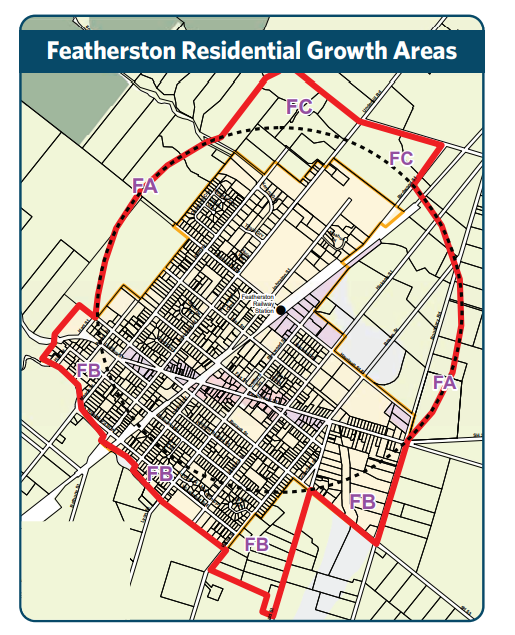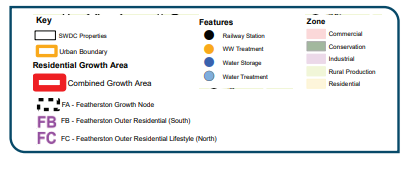Featherston Masterplan
The South Wairarapa Spatial Plan was released in early December 2021. The district-wide Spatial Plan identified Featherston as a Growth Node (growth area), and in 2022 we started master planning Featherston. In June 2024 Council adopted the Featherston Masterplan & Implementation Plan. Further consideration of Greytown and Martinborough will follow.
Background
Recent growth shows that Featherston is an attractive place to live; at the same time this growth brings new challenges such as the increase in house prices and rentals. The Master Plan was an opportunity to be responsive to these challenges and future opportunities.
The Masterplan process involved community and sector engagement, integrated town planning and
infrastructure assessment, the compilation of a draft, reporting, consultation and feedback, refinement, and the compilation of a final plan.
The Featherston Masterplan is a plan to enable transit-oriented growth around the train station, together with achieving a well-functioning urban environment that meets the needs of a diverse population. The town is recognised by the Wellington Regional Leadership Committee as a “Complex Development Opportunity” (or CDO) within the wider region, and a potential focus for investment from central government.
Key documents
View the Featherston Masterplan and Implementation Plan.
View the Featherston Masterplan – Discussion Document and Feedback webpage.
View the Featherston Masterplan – Commonly asked questions webpage.
FAQs about the Masterplan
What is a Masterplan
- An over-arching plan that shows where and how development might occur in Featherston over time (in other words, it shows spatial layout and structures development)
- It is not a resource management (ie. regulatory) process
- A plan that identifies what is important to iwi/hapū and community
- A plan that anticipates change, plans for it, and also looks to protect qualities most valued
- A plan that looks to integrate transport, housing, business, parks and reserves, infrastructure and community facilities
- A plan that identifies what needs to be done to deliver the Spatial Plan
Why a Masterplan for Featherston?
- It enables planned approach to growth, getting the best and coordinated use of public investments such as the train station, parks and reserves, community facilities, managing the impacts of the State highway, and integrating development
- It enables the co-ordination and integration of multiple agencies planning and delivery
- It captures community views and builds on existing local initiatives
- It can address new challenges, e.g. the need for affordable and different types of housing – the median house price in September 2021 was $621,850.
- Featherston was identified as a growth area in the Wellington Regional Growth Framework. Its estimated growth is around 900 persons over the next 30 years
Does the Masterplan consider current infrastructure?
The master-planning process includes looking at the status of our current infrastructure and what will be required in order to make the Masterplan come alive.
Master planning informs infrastructure planning which also then informs the Long-Term Plan and Annual Plans.
Who was involved in creating the Masterplan?
A number of stakeholders, groups and agencies were involved in developing the Featherston master plan, which included but was not limited to:
- The Featherston community
- Iwi/Mana whenua
- Community groups, sports groups, schools
- Local businesses
- Local government
- Central government – Kainga Ora, Kiwi Rail, Waka Kotahi/NZTA
We released two Concept Options in our Foundation Discussion Document in July. Fee
How this relates to the South Wairarapa Spatial Plan
The South Wairarapa Spatial Plan was the first step which led to the master planning of Featherston. The Spatial Plan provides a blueprint for what we want our district to look like in the future. Through this process, we were told to focus on
- Main street rejuvenation
- Housing options
- Connection with Wairarapa Moana
- Promoting local history
- Economic and community development opportunities
Unlike the other towns, master planning for Featherston will take in many aspects, such as residential housing, public open space, infrastructure, transport, as well as the town centre and commercial activities.
The South Wairarapa Spatial Plan aligns with our district vision and feeds into future annual plans, long-term plans and district plans. It will also provide guidance for the development of infrastructure.
This is consistent with the Wellington Regional Growth Framework, which looks at the wider Greater Wellington Region as a whole.
Link to the Spatial Plan here: Spatial Plan – SWDC SWDC
The Wellington Regional Growth Framework
Wellington Regional Growth Framework is a spatial plan and a blueprint for regional growth that has been developed by local government, central Government and iwi partners across the Wellington-Wairarapa-Horowhenua region. Featherston has been identified as being an urban renewal area.
Read more about the Wellington Regional Growth Framework here: Wellington Regional Growth Framework | WRGF Spatial Plan
The Featherston Growth Node Area
A growth area can be described as “an area identified for more urban development and renewal”. In the case of Featherston, this will include investigating more growth and development around the train station and the Featherston township.


